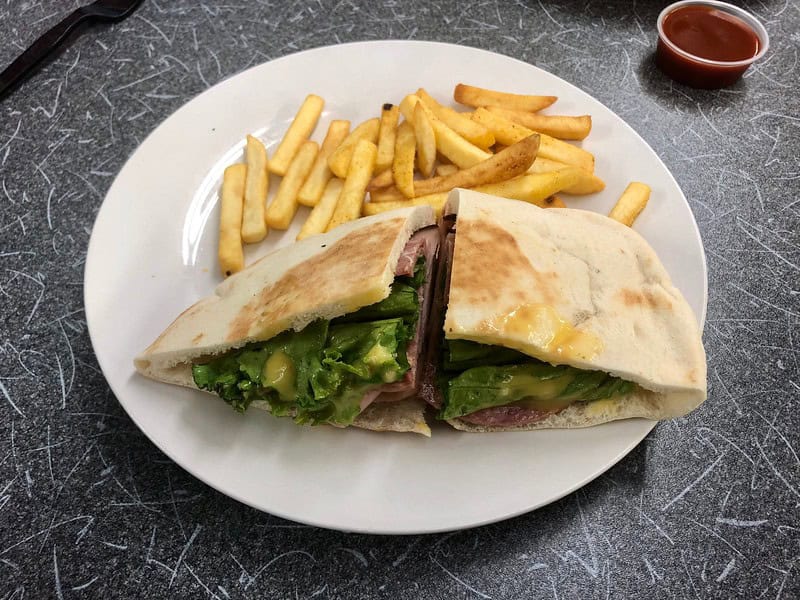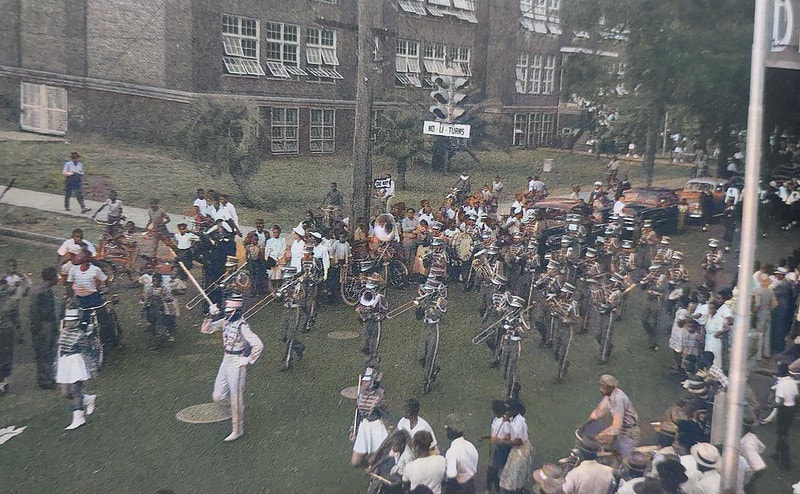
Jacksonville’s unique history has given the city a richly varied – if often slept-on – food scene. From Gullah Geechee specialties like garlic crabs to a homegrown style of barbecue to the ubiquitous camel rider sandwich, the area is brimming with delicious, distinctive and authentic cuisine. Here’s a look at nine signature foods of Jacksonville and the First Coast.
Mayport shrimp

All across Jacksonville and the First Coast, restaurants pride themselves in serving up fresh Mayport shrimp. This isn’t a particular species of shrimp; the designation “Mayport shrimp” refers to shrimp caught wild and unloaded in the Jacksonville area, especially the historic fishing village of Mayport.

First Coast waters are a very fertile breeding region for shrimp, and the crustaceans have been part of the local diet for thousands of years, dating back to the area’s original Native American inhabitants. What’s less appreciated is that the First Coast, in particular Fernandina, is the birthplace of modern shrimping. In the early 20th century, Fernandina shrimpers were the first to use motorboats instead of rowboats. They also adapted the New England otter trawl net to catch shrimp, creating the net that remains the industry standard today. Mayport especially became a thriving center, with many docks and local companies who distributed fresh catch across the region.
Local shrimping has declined since the 1990s due to loss of dock space and the influx of imported factory-farmed shrimp, locally known as “trash.” However, a number of local shrimpers persevere in local waters, and long-term plans call for rebuilding Mayport’s docks and strengthening the local shrimping and fishing industries.
Jacksonville-style garlic crabs

Garlic crabs are an underappreciated Jacksonville specialty. A variant of the well-known seafood boil, garlic crabs are cooked in a melted garlic butter sauce with sausage, corn, eggs and potatoes. Garlic crabs can be found across the coastal Southeast, but Jacksonville is the world capital of the dish, which is served up at dozens of local crab shacks and restaurants, especially in the Northside.

Garlic crabs are among the many Southern dishes that originate with the Gullah Geechee people. The Gullah Geechee are the descendants of West Africans enslaved in the Lowcountry, the coastal region stretching from Wilmington, North Carolina to St. Augustine. On the islands, inlets and creeksides of this area, the Gullah Geechee developed a culture, language and foodways all their own. Jacksonville doesn’t give itself enough credit as the garlic crab epicenter, but folks in the know travel far and wide for this delicacy, and some restaurants as far as Charleston feature “Jacksonville-style garlic crabs” on the menu.
All Gullah Geechee/Lowcountry cuisine, really

Garlic crabs aren’t the only dish of Gullah Geechee origin that’s pervasive in Jacksonville. Others that can be found across the city include the seafood boil, shrimp and grits, Hoppin’ John, salmon patties, gumbo, many rice dishes, she-crab soup and of course, barbecue (more on that in a minute). Many of these represent the combination of a seafood or other protein common in the local environment with widely available staples and flavorful spices to create a meal that could feed the whole family.
There’s a good reason for the ubiquity of Gullah Geechee foods in Jacksonville. Though it’s less well known than other Lowcountry cities like Charleston and Savannah, Jacksonville is home to the largest population of Gullah Geechee descendants in the country. But being less known has its benefits. In Jacksonville, you can find Gullah Geechee cooking that’s equal to anything Charleston and Savannah can offer – and you don’t have to pay tourist town prices to get it.
Datil peppers

Datil peppers are a small, waxy, and extraordinarily hot variant of the habanero-type pepper, Capsicum chinense. Many farms, gardens and front porches around the First Coast grow these legendary peppers – in fact, they’re so common that many locals don’t realize they’re a heavily localized variant that’s basically unknown anywhere else.
Two rival origin myths attribute the arrival of the datil pepper in St. Augustine to different groups with centuries of history in the First Coast: the Cubans and the Minorcans. Florida’s Cuban connection dates to the earliest days of Spanish colonization in the 16th century. The Minorcans, from the Spanish Mediterranean island of Menorca, came to Florida to settle the New Smyrna colony in the 18th century. When this venture failed, the Minorcans relocated north to St. Augustine, where their descendants number about 25,000 across St. Johns County today.

Datil peppers have long been part of local Minorcan cuisine, lending credence to the story that they brought it over. However, the peppers aren’t grown in Menorca; they’re habanero-type peppers native to the Caribbean and Central America – “habanero” refers to Havana, Cuba. A 1937 St. Augustine Record article confirms that datils were first brought to St. Augustine from Santiago, Cuba around 1880 by jellymaker Esteban B. Valls. The peppers thrived in Valls’ garden and quickly became popular around town, with the Minorcan community embracing them as their own. Today, datil peppers are common in dishes, sauces and marinades all over the First Coast.
Minorcan chowder

Datil peppers are the key ingredient in another local dish popularized by the Minorcan community of St. Augustine: Minorcan chowder. This thick soup comprises a red broth thickened and colored by tomatoes and tomato paste, supplemented with potatoes, vegetables and chopped clams or other seafood. The dish derives from the Mediterranean cooking traditions of Minorca, where hearty hearty tomato soups were popular with sailors and fishermen.
As a chowder with a tomato base, Minorcan chowder is most similar to Manhattan chowder, rather than the venerable New England clam chowder made with milk and cream. The distinguishing feature of Minorcan chowder is the datil pepper, which gives it a scorching heat with a touch of sweetness. Today, Minorcan chowder can be found not only in St. Augustine but in Jacksonville and elsewhere around the First Coast.
Honey drippers

Honey drippers are Jacksonville’s favorite frozen treat to beat the heat, as vendors proclaim. Quite simply, they’re Kool-Aid or fruit punch frozen in a plastic cup, making them a perfect concoction to take the edge off the brutal heat of a summer day or walk home from school. A simple treat that anyone with some drink mix and a freezer can make, they are often made at home or available from your neighborhood’s designated honey dripper lady.
This type of treat is found across the South and elsewhere under a variety of names. It’s known as a “thrill” in Savannah, “freeze cup” in Michigan, “huckabuck” in Louisiana, Macon, Georgia, and elsewhere, “chilly cups” in Cleveland, “limber” in Puerto Rico and other names that are tougher to pin down geographically like “Dixie cup,” “Lilly Dilly” and “Cherry Berry.” What’s specific to the Jacksonville area is the name “honey dripper,” which isn’t common anywhere else.
Camel riders

Camel riders are Jacksonville’s signature sandwich, and probably the city’s single most distinctive food. A creation of Jacksonville’s large and vibrant Arab American community, camel riders are a pita stuffed with ham, salami, bologna and sandwich fixings, the perfect cheap, tasty meal for working people on the go.
Jacksonville’s Arab community dates back to the 1890s, and has been influential in all parts of life, from business to politics to healthcare, but Arabs have been especially influential in the local food and restaurant scene. The camel rider’s origin is debated, but it’s often traced to Joe Assi, a Lebanese-born baker who owned the Gold Room restaurant in the early 1960s. Assi started selling a cold-cuts sandwich in pita bread that he ultimately named the “desert rider.” By the mid-1970s, riders had spread across Jacksonville at eateries like the Sheik, Desert Rider and Pinegrove Market and Deli.

The spread of riders has led to the creation of several variations, of which the most popular include the veggie rider, the steak-in-a-sack and my personal favorite, the garlic shrimp rider. While riders can be found in some other cities, only Jacksonville can boast them in concentration; today the city is home to at least 50 eateries that serve them. Riders are a true Jacksonville culinary staple and one of the many legacies of the city’s thriving Arab American community.
Lubi’s

Jacksonville’s sandwich shops produced another distinctive local item: the Lubi. Now served only at the last Lubi’s restaurant at 11633 Beach Blvd., the original Lubi is a steamed variety of a sub or hoagie featuring ground sirloin cooked with secret spices, served in a roll with onions, peppers and melted American cheese. The sandwiches come in several other variants, the most popular of which is the mozzarella Lubi.
Lubis are the invention of LuLa Wallace, a member of an Arab-American family involved in the restaurant business. She founded the first Lubi’s restaurant in 1969, combining her first name with that of her husband, Bill Wallace. Initially, Lubi’s served camel riders and other typical sandwich shop fare, but Wallace wanted to try something new. After visiting a restaurant in Orlando that steamed its sandwiches, Wallace seized on the idea, and soon the Famous Lubi and its variants were born.

Lubi’s was a hit, and Wallace and her children expanded the chain, which came to own five restaurants across Jacksonville at its peak. Wallace died in 2014 and most of the former Lubi’s have closed, but the Beach Boulevard location still serves up steaming hot subs as they’ve been made for decades.
Jacksonville-style barbecue

Barbecue has its roots in Native American, Spanish and African culinary heritage. The word “barbecue” comes from “barbakoa”, a term for open-fire grilling used by the Taino people of the Caribbean. Southeastern Native Americans also used the technique, with Mocama Timucua from what’s now Jacksonville among the first people whose barbecue traditions entered the written record. Later, Spanish colonists and enslaved West Africans brought Old World animals, sauces and flavors into the mix.

Barbecue is ubiquitous across the South, with many regional variations competing for popularity. While it hasn’t gotten the credit it deserves, Jacksonville is home to its own particular style of barbecue. What distinguishes this style is the unique mustard-based sauce, which typically includes vinegar, molasses or sugar. This mix of ingredients makes it darker, sweeter and thicker than other mustard-based barbecue sauces like those found in the Carolinas. Today, this regional style can be found at most old school Jacksonville barbecue joints like Holley’s, Jenkins, Cotten’s, Jerome Brown’s and The Pig.
Contact Bill Delaney at wdelaney@moderncities.com. Bill Delaney’s book Secret Jacksonville, a Guide to the Weird, Wonderful, and Obscure is out now. Order a signed copy at thejaxsonmag.com/books.







